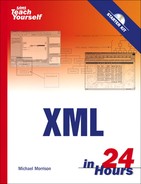XML is a technology that is growing by leaps and bounds. Granted, the core XML language is very established, but the many closely related technologies are evolving rapidly. For this reason, it’s important to try and keep up with what’s going on in the XML community. The best way to stay on top of XML is to be a committed web surfer. Fortunately, the Web is full of information on XML and is by far the best place to learn about what’s new in the XML world. By regularly visiting a few web sites, you can stay abreast of the latest happenings with XML, which is important if you plan on using any XML-related technology.
This appendix is divided into several sections that target specific online XML resources. I encourage you to check out some of these resources and judge for yourself which ones you find the most useful. Keep in mind that, in addition to keeping up with changes in XML, many of the resources are also great educational outlets for sharpening your XML skills.
General XML resources consist of web sites that take a wide aim at XML—these web sites provide information ranging from XML basics to heavy-duty XML application development. You’ll also find some interesting articles containing general commentary on the state of XML, along with the relationship between XML technologies. Following are the general XML resources I recommend you take a look at:
XML.com—http://www.xml.com/
XML.org—http://www.xml.org/
XML at About.com—http://webdesign.about.com/od/xml/
XML Pitstop—http://www.xmlpitstop.com/
DevX XML Zone—http://www.devx.com/xml/
The XML Files—http://www.webdeveloper.com/xml/
Web Monkey (XML)—http://www.hotwired.com/webmonkey/xml/
Microsoft’s XML web site—http://msdn.microsoft.com/xml/
XML Resources—http://www.xmlresources.com/
Wikipedia (XML)—http://en.wikipedia.org/wiki/Xml/
W3C’s XML in 10 Points—http://www.w3.org/XML/1999/XML-in-10-points
As with most software technologies, tools play an important role in developing applications with XML. There are a couple of different kinds of tools that enter the picture when it comes to XML development:
Authoring tools
Validation tools
XML authoring tools are used to create and edit XML documents. The most basic authoring tool is a simple text editor, such as Windows Notepad, which isn’t XML-specific but nonetheless provides a means of creating and editing XML documents. The decision to use a more full-featured XML authoring tool has everything to do with personal preference and how much you’re willing to spend. Following are some of the popular XML authoring tools that are currently available:
<oXygen/> XML Editor—http://www.oxygenxml.com/
XML Spy—http://www.xmlspy.com/
XML Writer—http://www.xmlwriter.net/
EditiX—http://www.editix.com/
XMetaL—http://www.xmetal.com/
Stylus Studio—http://www.stylusstudio.com/
Adobe FrameMaker—http://www.adobe.com/products/framemaker/
Vervet Logic Web XML Pro—http://www.vervet.com/xmlpro.php
Although most commercial XML authoring tools include support for document validation, you may need to validate documents outside of a fancy authoring tool. In this case, you will want to use a pure XML validation tool, which is actually a web site that provides services for validating XML documents. Web-based validation tools are interesting in that they don’t require you to download or install anything—just point and click! Following are a few of the validation tools that support XML:
STG XML Validation Form—http://www.stg.brown.edu/service/xmlvalid/
W3C Validator for XML Schema—http://www.w3.org/2001/03/webdata/xsv/
XML Schema Validator—http://apps.gotdotnet.com/xmltools/xsdvalidator/
W3C XHTML Validation Service—http://validator.w3.org/
There are some XML tools that defy classification. Most of these “other” tools process XML documents in some way and produce results, such as transformed documents. They certainly can’t be considered authoring or validation tools, so I’ll just refer to them as “other” tools. Following is a list of some of these other XML tools:
TIBCO Extensibility Platform—http://www.tibco-ext.com/
HTML Tidy—http://www.w3.org/People/Raggett/tidy/
XFA Script—http://www.xmlforall.com/cgi/xfa?XFAScript
The TIBCO Extensibility Platform offers a unique approach to XML schema development by providing a graphical user interface for creating schemas in a very general sense. Once a schema is constructed, you decide the format in which you want it stored, such as DTD or XSD. HTML Tidy is a command-line tool that was initially designed to clean up sloppy HTML code but also supports converting HTML code to XHTML code. XFA Script by XML For All is a scripting language implemented as an XML vocabulary. XFA Script is interesting because it uses XML syntax to implement a scripting language. XML For All also offers an XML editor called XFA Edit that is available for the Windows platform.
As you know by now, XML is used to create markup languages geared toward representing a particular type of information. These XML-based languages represent the end-result of applying XML to solve real-world problems. Following are some of the major XML-based languages created to solve such problems:
Wireless Markup Language (WML)—http://www.openmobilealliance.org/
Open Financial Exchange (OFX)—http://www.ofx.net/
eXtensible Business Reporting Language (XBRL)—http://www.xbrl.org/
Resource Description Framework (RDF)—http://www.w3.org/RDF/
Really Simple Syndication (RSS)—http://blogs.law.harvard.edu/tech/rss
Mathematical Modeling Language (MathML)—http://www.w3.org/TR/REC-MathML/
Open eBook (OeB)—http://www.openebook.org/
OpenDocument—http://www.oasis-open.org/committees/tc_home.php?wg_abbrev=office
Web Ontology Language (OWL)—http://www.w3.org/TR/owl-guide/
Platform for Privacy Preferences Project (P3P)—http://www.w3.org/TR/P3P/
Simple Object Access Protocol (SOAP)—http://www.w3.org/TR/soap/
Scalable Vector Graphics (SVG)—http://www.w3.org/Graphics/SVG/
Synchronized Multimedia Interchange Language (SMIL)—http://www.w3.org/TR/SMIL/
Universal Description, Discovery, and Integration (UDDI)—http://www.uddi.org/
Web Services Description Language (WSDL)—http://www.w3.org/TR/wsdl
eXtensible Application Markup Language (XAML)—http://www.xaml.net/
3-D Modeling Language (3DML)—http://www.flatland.com/
VoiceXML—http://www.voicexml.org/
Chemical Markup Language (CML)—http://wwmm.ch.cam.ac.uk/moin/ChemicalMarkupLanguage
XML News—http://www.xmlnews.org/
Human Markup Language (HumanML)—http://www.humanmarkup.org/
XML is a technology that revolves around rigid standards that are set forth by the W3C. In order for XML to be consistently used by developers, these standards must be adhered to carefully. XML standards are set forth in documents called specifications, or specs, which are easily accessible on the Web. New technology specifications typically go through several developmental stages on the way to becoming a formal recommendation, which is essentially a technology that is complete and ready to be adopted by the web community. A W3C specification that has yet to become a recommendation is known as a working draft. Following are the most important W3C specifications related to XML:
XML Namespaces—http://www.w3.org/TR/REC-xml-names/
XML Schema—http://www.w3.org/XML/Schema
XPointer—http://www.w3.org/TR/xptr/
DOM Level 1—http://www.w3.org/DOM/
XQuery—http://www.w3.org/TR/xquery/
Unicode character encoding—http://www.unicode.org
